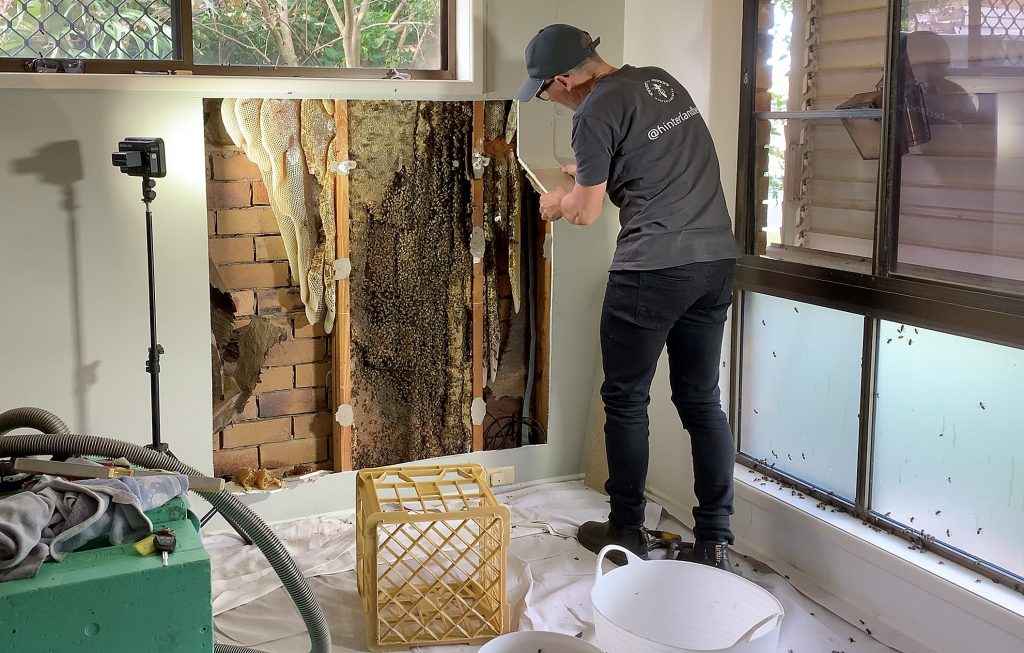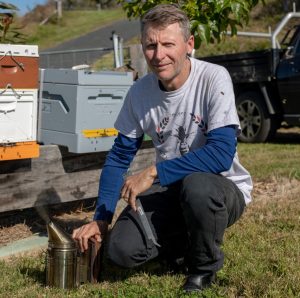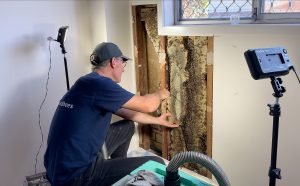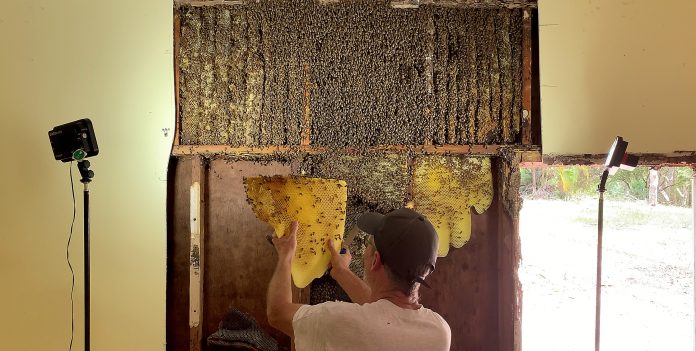Honey, apples, avocados, grapes, mangoes, strawberries, cashews, coffee, cocoa, broccoli, carrots, chillies. These and many other foods would not exist were it not for bees pollinating the plants.
With bee populations around the world under threat, Maleny man Scott Whitaker of Hinterland Bees has become somewhat of a bee whisperer, removing wayward hives and swarms across the Sunshine Coast and Brisbane and rehoming them on his property in North Maleny, where he produces Maleny Honey from rescued bee hives.
His bee-friendly system for removing hives from the walls of homes and commercial buildings means the pest man doesn’t need to be called to spray toxic chemicals and the bees get to see another day, pollinate another plant, and make some more delicious honey.
“Last spring and summer, I did about 50 removals,” Mr Whitaker says.

“They come in little hotspots. In early spring, I got a whole bunch of jobs at Golden Beach. I’ve lost count of the number of removals I’ve done at Sunrise Beach this season.
“With the drought breaking, there were lots of resources for the bees and the consequence of that is not just lots of honey, but the bees want to reproduce and swarm. Then they get into people’s walls and ceilings and keep us on our toes.”
Bees love brick veneer houses which have weep holes in the bricks that allow them to enter into the wall cavities. A bee hive can happily live inside the walls or ceilings of a house for many years, growing larger and larger. A hive can contain 60,000 bees, plus more than 100 kilograms of honey. The only complete removal solution is a cut-out.
Help keep independent and fair Sunshine Coast news coming by subscribing to our free daily news feed. All it requires is your name and email. See SUBSCRIBE at the top of this article
This involves Mr Whitaker cutting out all the honeycomb and vacuuming up the bees using a special vacuum that doesn’t harm them. He is continually searching for the queen bee during this process.
It recently took him 12 hours to remove a massive hive from a barn in Towen Mountain near Nambour and he didn’t find the queen bee until the last 20 minutes of the job.
“When I do these jobs, I start them and don’t really have a break, other than an occasional stop for a drink of water or a snack, until I finish.”
 It’s hard but satisfying work and Mr Whitaker feels by saving the bees from extermination, he’s doing his bit for the environment.
It’s hard but satisfying work and Mr Whitaker feels by saving the bees from extermination, he’s doing his bit for the environment.
His job as a bee rescuer began in 2014 when a friend asked him to help remove a swarm of bees that had set up home at a school in Bald Hills.
“Usually when I do a cut-out, I cut 30 to 50 kilos of honey out of the wall and ceiling, with all the wax,” he says.
“It involves the disassembly of parts of the wall or ceiling sheeting to expose the nest. If you don’t remove all the comb and fill the void with insulation, it will almost certainly result in another swarm moving into the space, even if the previous colony has been poisoned.
“With removal work, we tend to get two types of clients,” he says. “Ones that act really quickly as soon as the bees move in. Then we encounter the clients that for one reason or another – perhaps they’ve had bad advice from people who have said the bees will eventually go away, you can just let them stay there – then three years down the track, all of a sudden they have bees stinging the dog or you can’t get a mower near it and you have a wall full of honey. They’re the big jobs that can take hours.
“Fortunately, a lot of exterminators don’t exterminate bees anymore. A number of pest controllers refer work on to me, which is nice.
“To exterminate a nest is only solving half the problem. For a homeowner, the bigger problem is the material that gets left inside the wall. If you kill a nest, what generally happens is the nest gets attacked by a small hive beetle, which will go in and defecate into the honey stores, which ferments it and turns it into this brown ooze, which basically degrades the nest. It starts to collapse and fall apart.
“Imagine what that’s like in the ceiling of the house. It’s diabolical and it spreads out and destroys the ceiling. Once that clears out, you’ll get wax moth, which will consume all the wax, cockroaches and ants will move in.
“Within time, you are almost guaranteed to attract another swarm of bees in there, because bees do so much communication through pheromones. The queen pheromone is in that cavity and will attract scout bees looking for a place to move into. It’s a never-ending cycle if you don’t deal with it properly.
“I think there are still pest controllers that will kill colonies, but it generally creates a much bigger headache for the owner. They’ve still got to cut the wall or ceiling open and extract that material and make repairs to make sure they don’t get a reinfestation.”
As the only full-time bee removal expert on the Sunshine Coast, Mr Whitaker is run off his feet. He balances hive removal with managing his own hives – he has nine different apiary sites stretching from Mapleton to Maleny and Peachester, with 150 hives in total.
“I put a lot of effort into trying to mitigate swarms from my hives,” he says.
“From a business point of view, there’s no point me dealing with other people’s bee problems if my hives are going to swarm. Swarming happens when the colony runs out of space, when they are responding to really good seasonal conditions and lots of pollens are coming in to feed the developing larvae.

“We tend to get a bit of a resurgence towards the end of summer. The bees go, things are great, the population inside the hive starts to increase, then they want to swarm.
“The best beekeeper in the world would have had trouble trying to prevent their hives swarming on the Sunshine Coast this year.
“It’s not the sort of thing I’m complaining about. I’d much rather it be that way. Out there in the community, there’s a growing interest in bees – they are sort of a canary in the coalmine.
“They give us an idea of what’s happening in the environment. If there are lots of swarms around, it’s because conditions are good for bees. Beekeeping is very in touch with the environment and it feels like a legitimately good thing to be doing.”





